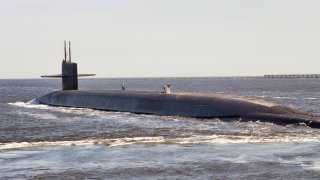'Surface the Missile Submarine!': A Navy Ohio-Class Missile Sub Surfaced to Warn Russia
The U.S. Navy showcased its might in the Norwegian Sea with the surface appearance of USS Tennessee and USS Normandy, supported by a P-8A Poseidon and an E-6B aircraft.
Summary and Key Points: The U.S. Navy showcased its might in the Norwegian Sea with the surface appearance of USS Tennessee and USS Normandy, supported by a P-8A Poseidon and an E-6B aircraft.

-The USS Tennessee is important as this is an Ohio-Clas SSBN missile submarine. Being surfaced on the top of the water is likely a signal to give Russia pause.
-This display followed the sighting of a Russian Yasen-M class submarine near Scotland, en route to Cuba, underscoring the Kremlin's nuclear threats amidst its invasion of Ukraine. The advanced capabilities of the Yasen-class submarine, such as carrying Zircon hypersonic cruise missiles, contrast with the formidable power of the Ohio-class USS Tennessee, which can unleash up to 192 nuclear warheads. This naval maneuver aims to counter Russian aggression and reaffirm NATO's strategic deterrence.
US Navy Showcases Power in Norwegian Sea Amid Russian Submarine Activity
The U.S. Navy undertook a show of force in the Norwegian Sea this week when USS Tennessee and USS Normandy cruised on the surface of the waters. The ships were accompanied by a P-8A Poseidon and an E-6B aircraft.
Days earlier, a Russian nuclear-powered submarine was spotted off the coast of Scotland as it made its way to Cuba. The Yasem-M class vessel was accompanied by three Russian surface ships as part of planned military drills in the Atlantic. The Kremlin, trying to exude strength and prowess amid its invasion of Ukraine, was using these warships to indicate it remains a global power.
The U.S. and its NATO allies have grown concerned in recent months with Russian President Vladimir Putin’s nuclear-flavored rhetoric. The Kremlin leader has threatened on several occasions to unleash Moscow’s nuclear arsenal. Since Russia’s nuclear-armed submarines would be used to act on such threats, their surfacing is deeply worrisome.
Prior to an election in March, Putin claimed that Russia was technically prepared for nuclear war. While the president said he was not rushing to this kind of escalation, the Kremlin chief has referenced this capability before. In February, Putin warned nuclear war would be on the table if NATO members deployed troops to aid Kyiv’s defensive efforts in the war. In May, Putin instructed Russian forces to practice deploying tactical nuclear weapons as part of military drills to address what he claimed were threats made by the West.
Clearly, the Kremlin is parading its nuclear capabilities to support its war efforts in Ukraine. Since Russia commands one of the largest nuclear-powered ballistic missile submarine fleets in the world, these warships are particularly menacing.
Russia’s Yasen-Class Kazan Submarine
The Yasen-class submarine that surfaced in the Atlantic last month is one of Russia’s newest vessels. Commissioned in 2021, K-561 Kazan sports a heavy armament, including 3M-54 Kalibr and P-800 Oniks cruise missiles. According to reports, each submarine in this class can carry 24 Oniks or 32 Kalibr missiles, in addition to mines and anti-ship missiles.
The Yasen ships are also the first to be equipped with a fourth-generation nuclear reactor, which purportedly has a quarter-century-long core life and will not require refueling. More recently, Russian state-run media has claimed that Yasen warships will soon be armed with the cutting-edge Zircon hypersonic cruise missile. The 3M22 Zircon can reportedly reach a top speed of Mach 9.0, making it perhaps Moscow’s most threatening new weapon.
How the Kazan Compares to the USS Tennessee
The U.S. Navy’s Ohio-class submarines are the crux of America’s sea-based nuclear deterrent strategy. USS Tennessee, which recently surfaced in the Norwegian waters, is capable of carrying 24 Trident II missiles. This armament capacity makes Tennessee and her Ohio-class SSBN sister ships some of the most lethal assets in the Navy’s arsenal.

As detailed by Sebastien Roblin, “As a Trident II reenters the atmosphere at speeds of up to Mach 24, it splits into up to eight independent reentry vehicles, each with a 100- or 475-kiloton nuclear warhead. In short, a full salvo from an Ohio-class submarine—which can be launched in less than one minute—could unleash up to 192 nuclear warheads to wipe twenty-four cities off the map. This is a nightmarish weapon of the apocalypse.”
This sophisticated arsenal is not the only reason USS Tennessee is so formidable. The Ohio-class ships all feature state of the art propulsion systems, streamlined hulls, and advanced sonar baffles to enable stealth in the waters.
What About the E-6B and Poseidon P-8?
While the presence of USS Tennessee alone should send Moscow the message to back off, the additional flyover of an E-6B Mercury and P-8 Poseidon displayed the Navy’s airborne prowess. According to Naval Air Systems Command, the Mercury "provides survivable, reliable, and endurable airborne Nuclear Command, Control, and Communications (NC3) for the president, secretary of defense, and US Strategic Command.” The P-8 also operates intelligence, surveillance, and reconnaissance roles and can carry out anti-submarine warfare and anti-surface warfare missions.
About the Author: Maya Carlin, Defense Expert
Maya Carlin, National Security Writer with The National Interest, is an analyst with the Center for Security Policy and a former Anna Sobol Levy Fellow at IDC Herzliya in Israel. She has by-lines in many publications, including The National Interest, Jerusalem Post, and Times of Israel. You can follow her on Twitter: @MayaCarlin.


